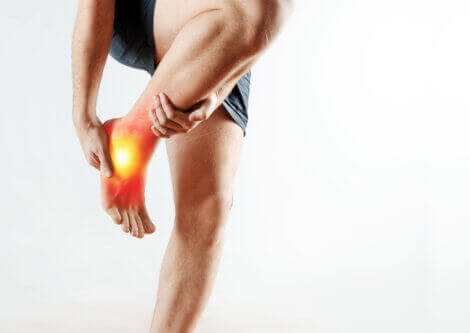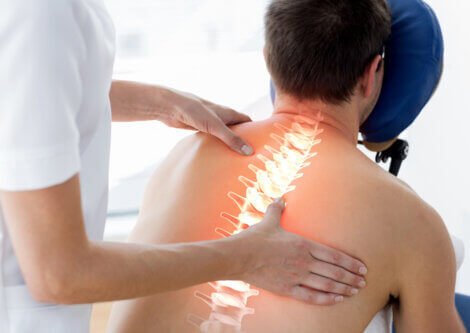Infrared Thermography: What's It For?

The more tools health care professionals have at their disposal to diagnose a condition, the better. Infrared thermography is an interesting and useful option for physiotherapists. It can help them to detect and diagnose different conditions.
Below, we’ll take a look at everything that this technique involves. We’ll see how it’s used, what it is, and above all, what it can be used for.
Infrared thermography
Infrared thermography allows a doctor to check a patient’s skin temperature objectively. It includes an infrared camera and specialized software. Together, these items can help a health care professional to get a clearer idea of their patient’s problem.
With that in mind, we’re talking about a tool that allows a doctor to get extra information on any part of the body. They just need to point the camera towards the affected area and the device does the rest. It’s also possible to do sweeps of different parts of the body to check if there may be a problem that they didn’t previously know about.
The importance of objective information
It’s good to remember the importance of the doctor being able to get objective, trustworthy information. Being able to pinpoint a specific symptom is a great advantage for specialists. It’s not the same hearing, ‘It’s sore here’, as it is to know that there’s a specific spot in the body with inflammation that’s raising the surface temperature.

Here’s where an infrared thermography tool can come in handy. For instance, physiotherapists can measure the range of movement or use a scale to measure pain.
Infrared thermography can be an excellent additional tool in the kit. It can give the professional information that an ultrasound or other tools can’t provide.
What’s it for?
As we’ve seen above, infrared thermography can give an exact value to the surface temperature of the patient’s skin. This can be important for several reasons.
In the first place, it can detect local inflammation. A red area will let the physiotherapist know that a certain structure of the body is receiving an abnormally high blood flow. And if it’s in a very specific area, it’s probably to do with inflammation in that spot.
It can also be useful to confirm circulation problems. If one area is cooler than it should be, it’s because it’s not getting enough blood flow. Good circulation will make it warmer.
Slow circulation can be due to various causes, but at least your doctor can verify that there’s a problem in a certain spot, that’s causing the blood flow to lessen. For instance, it’s common for the hands or feet to have circulation problems.
Thirdly, the body’s nervous system directs blood to both sides of the body equally, or symmetrically. That’s another reason why the doctor needs to know if the skin temperature is even.
Checking this can let the doctor know if there’s a problem that’s making the body direct different levels of blood flow on either side. For instance, myofascial pain syndrome is one condition where there’s a difference in temperature between the two sides of the body, as this study shows.
Lastly, in the sports environment, infrared thermography has been useful when it comes to preventing injury. This is because it can identify the signs of a potential injury before the actual injury occurs. That’s what a study shows that was published in the International Journal of Medicine and Science in Physical Education and Sport.
A new and useful tool
Using infrared thermography equipment isn’t complicated. Health care professionals can learn to use it without difficulty in just a short time. However, as with any new technique, they must first undertake some training to familiarize themselves with the equipment.

In fact, the most important aspect that the professional will need to learn is interpreting the data. Knowing what to make of a certain anomaly is just as important as using the camera and the software correctly.
Infrared thermography: a great ally
What can you take away from all of the above? Well, we’ve seen that infrared thermography can be a very valuable tool for health care professionals. It’s uncomplicated equipment and it just takes a short time to be able to use it correctly.
Also, it’s a non-invasive and quick technique that can give the doctor valuable objective information. Infrared thermography allows the professional to get information that can be decisive in diagnosing a condition and deciding on a treatment option. This makes it a very interesting tool that can be useful in various applications.
With that in mind, don’t be surprised if you visit a specialist in circulatory problems, for instance, and they point a camera at you. This technique is becoming more widely used, and patients are seeing the benefits.
The more tools health care professionals have at their disposal to diagnose a condition, the better. Infrared thermography is an interesting and useful option for physiotherapists. It can help them to detect and diagnose different conditions.
Below, we’ll take a look at everything that this technique involves. We’ll see how it’s used, what it is, and above all, what it can be used for.
Infrared thermography
Infrared thermography allows a doctor to check a patient’s skin temperature objectively. It includes an infrared camera and specialized software. Together, these items can help a health care professional to get a clearer idea of their patient’s problem.
With that in mind, we’re talking about a tool that allows a doctor to get extra information on any part of the body. They just need to point the camera towards the affected area and the device does the rest. It’s also possible to do sweeps of different parts of the body to check if there may be a problem that they didn’t previously know about.
The importance of objective information
It’s good to remember the importance of the doctor being able to get objective, trustworthy information. Being able to pinpoint a specific symptom is a great advantage for specialists. It’s not the same hearing, ‘It’s sore here’, as it is to know that there’s a specific spot in the body with inflammation that’s raising the surface temperature.

Here’s where an infrared thermography tool can come in handy. For instance, physiotherapists can measure the range of movement or use a scale to measure pain.
Infrared thermography can be an excellent additional tool in the kit. It can give the professional information that an ultrasound or other tools can’t provide.
What’s it for?
As we’ve seen above, infrared thermography can give an exact value to the surface temperature of the patient’s skin. This can be important for several reasons.
In the first place, it can detect local inflammation. A red area will let the physiotherapist know that a certain structure of the body is receiving an abnormally high blood flow. And if it’s in a very specific area, it’s probably to do with inflammation in that spot.
It can also be useful to confirm circulation problems. If one area is cooler than it should be, it’s because it’s not getting enough blood flow. Good circulation will make it warmer.
Slow circulation can be due to various causes, but at least your doctor can verify that there’s a problem in a certain spot, that’s causing the blood flow to lessen. For instance, it’s common for the hands or feet to have circulation problems.
Thirdly, the body’s nervous system directs blood to both sides of the body equally, or symmetrically. That’s another reason why the doctor needs to know if the skin temperature is even.
Checking this can let the doctor know if there’s a problem that’s making the body direct different levels of blood flow on either side. For instance, myofascial pain syndrome is one condition where there’s a difference in temperature between the two sides of the body, as this study shows.
Lastly, in the sports environment, infrared thermography has been useful when it comes to preventing injury. This is because it can identify the signs of a potential injury before the actual injury occurs. That’s what a study shows that was published in the International Journal of Medicine and Science in Physical Education and Sport.
A new and useful tool
Using infrared thermography equipment isn’t complicated. Health care professionals can learn to use it without difficulty in just a short time. However, as with any new technique, they must first undertake some training to familiarize themselves with the equipment.

In fact, the most important aspect that the professional will need to learn is interpreting the data. Knowing what to make of a certain anomaly is just as important as using the camera and the software correctly.
Infrared thermography: a great ally
What can you take away from all of the above? Well, we’ve seen that infrared thermography can be a very valuable tool for health care professionals. It’s uncomplicated equipment and it just takes a short time to be able to use it correctly.
Also, it’s a non-invasive and quick technique that can give the doctor valuable objective information. Infrared thermography allows the professional to get information that can be decisive in diagnosing a condition and deciding on a treatment option. This makes it a very interesting tool that can be useful in various applications.
With that in mind, don’t be surprised if you visit a specialist in circulatory problems, for instance, and they point a camera at you. This technique is becoming more widely used, and patients are seeing the benefits.
All cited sources were thoroughly reviewed by our team to ensure their quality, reliability, currency, and validity. The bibliography of this article was considered reliable and of academic or scientific accuracy.
- S. Zambrano, K. Gregorio. La termografía infrarroja como herramienta complementaria para el diagnóstico del dolor miofascial en fisioterapia. Una revisión sistemática. Trabajo fin de grado para la Universidad Miguel Hernández de Elche, 2019.
- J. Marins, I. Fernández-Cuevas, J. Arnaiz-Lastras et al. Aplicaciones de la termografía infrarroja en el deporte: Una revisión. Revista internacional de Medicina y Ciencias de la Actividad Física del Deporte, Vol. 15, Núm 60 (2015): 805-824
- M. Morales, E. Medina, A. Carnevali et al. Termografía infrarroja y el estudio de riesgos de lesiones músculo esqueléticas. Vol. 10, Núm. 1 (2010)
This text is provided for informational purposes only and does not replace consultation with a professional. If in doubt, consult your specialist.








